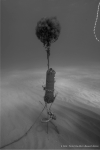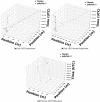A remote sensing approach for exploring the dynamics of jellyfish, relative to the water current
- PMID: 37679453
- PMCID: PMC10485037
- DOI: 10.1038/s41598-023-41655-8
A remote sensing approach for exploring the dynamics of jellyfish, relative to the water current
Abstract
Drifting in large numbers, jellyfish often interfere in the operation of nearshore electrical plants, cause disturbances to marine recreational activity, encroach upon local fish populations, and impact food webs. Understanding the dynamic mechanisms behind jellyfish behavior is of importance in order to create migration models. In this work, we focus on the small-scale dynamics of jellyfish and offer a novel method to accurately track the trajectory of individual jellyfish with respect to the water current. The existing approaches for similar tasks usually involve a surface float tied to the jellyfish for location reference. This operation may induce drag on the jellyfish, thereby affecting its motion. Instead, we propose to attach an acoustic tag to the jellyfish's bell and then track its geographical location using acoustic beacons, which detect the tag's emissions, decode its ID and depth, and calculate the tag's position via time-difference-of-arrival acoustic localization. To observe the jellyfish's motion relative to the water current, we use a submerged floater that is deployed together with the released tagged jellyfish. Being Lagrangian on the horizontal plane while maintaining an on-demand depth, the floater drifts with the water current; thus, its trajectory serves as a reference for the current's velocity field. Using an acoustic modem and a hydrophone mounted to the floater, the operator from the deploying boat remotely changes the depth of the floater on-the-fly, to align it with that of the tagged jellyfish (as reported by the jellyfish's acoustic tag), thereby serving as a reference for the jellyfish's 3D motion with respect to the water current. We performed a proof-of-concept to demonstrate our approach over three jellyfish caught and tagged in Haifa Bay, and three corresponding floaters. The results present different dynamics for the three jellyfish, and show how they can move with, and even against, the water current.
© 2023. Springer Nature Limited.
Conflict of interest statement
The authors declare no competing interests.
Figures







References
-
- Bosch-Belmar M, et al. Jellyfish impacts on marine aquaculture and fisheries. Rev. Fish. Sci. Aquacult. 2020;29:242–259. doi: 10.1080/23308249.2020.1806201. - DOI
-
- Hays GC, et al. Diving behaviour of jellyfish equipped with electronic tags. J. Plankton Res. 2008;30:325–331. doi: 10.1093/plankt/fbn003. - DOI
Publication types
MeSH terms
LinkOut - more resources
Full Text Sources
Medical

